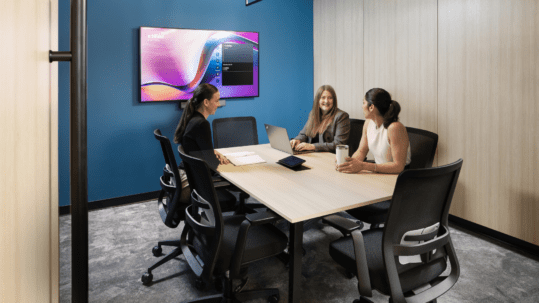Few workplaces are more deeply tied to the idea of traditional office layout than the legal firm. Law offices have typically stuck to a philosophy that’s lasted over a century: no matter how many people appear in the firm’s name, lawyers are individuals with cordoned-off, dedicated private offices. To give them any other office layout, whether open-plan or based around revolving workstations, would be to deny a longstanding idea of the private office being a personal goal and a status symbol.
But the reality of the real estate market’s costs and the growing lack of commercial office space has made that approach increasingly impractical. Compounding things is the fact that fast-moving changes to the legal profession — driven by new tech, generational turnover, tough competition, and shifting demands from clients — are becoming a major factor in how the modern law office is set up and laid out. Future-proofing legal firms in the face of these changes while preserving old law office traditions sounds like it could be a tricky task, but these changes can be gradual and non-disruptive in a way that makes them viable in the long run.
Here are some optimizations that can make the transition easier:
Augment Private Spaces with Open Spaces
Naturally there will always be a need for private offices in a law firm, considering client confidentiality and other matters that are best settled behind closed doors. Still, dedicating at least some of your floorplan to open space for socializing and co-working isn’t just a good way to optimize space and modernize the workplace, it can be a necessity for workplace morale and collaborative strength. And the literal transparency of visible workplaces — such as glass-walled offices and meeting rooms — can give off a sense of figurative transparency, too, fostering positive associations with inclusion and openness.
Incorporate Flexible Workstations
Not every work task’s going to be the same, but there’s not necessarily a need to dedicate separate workspaces for them. Using multi-configuration furniture that allows for in-person, small group, and virtual/online communication in the same space will go a long way towards keeping an office’s options open when it comes to configuration.
Use Tech to Increase Mobility
Lawyers will always want the option to work from any remote location outside the office as well as in it. Mobile tech has done much to improve and simplify the possibilities for remote collaboration, document-sharing, and ease of communication, so the issues of office layout alone aren’t going to cover every aspect of workplace optimization. Giving both access to and accommodations for tech-assisted mobile work will provide employees and clients alike the flexibility of choice that remote-work options provide.
Learn what else Aura can do for you and your office space! Feel free to contact us, and see what other spaces we’ve brought to life.






